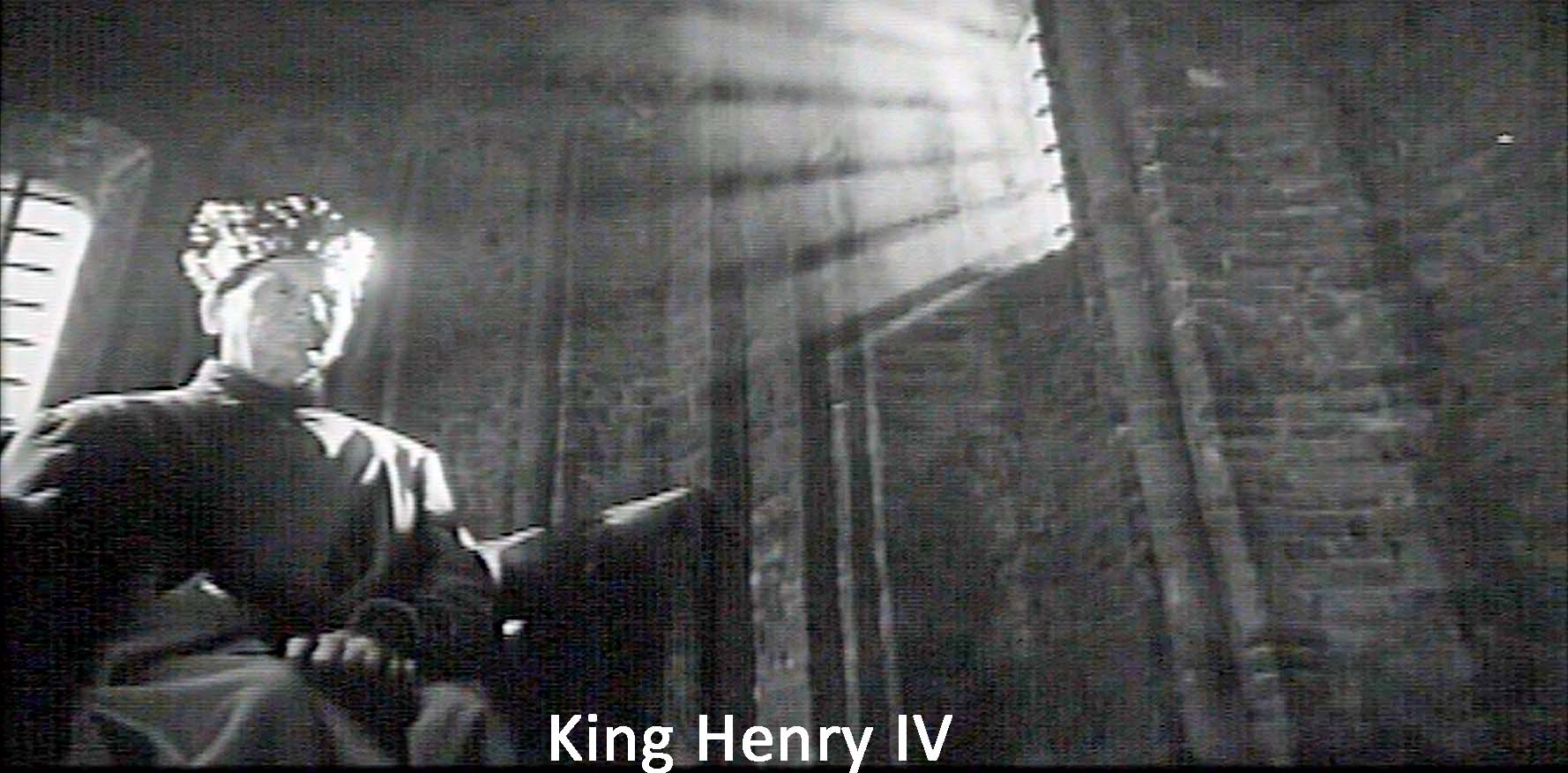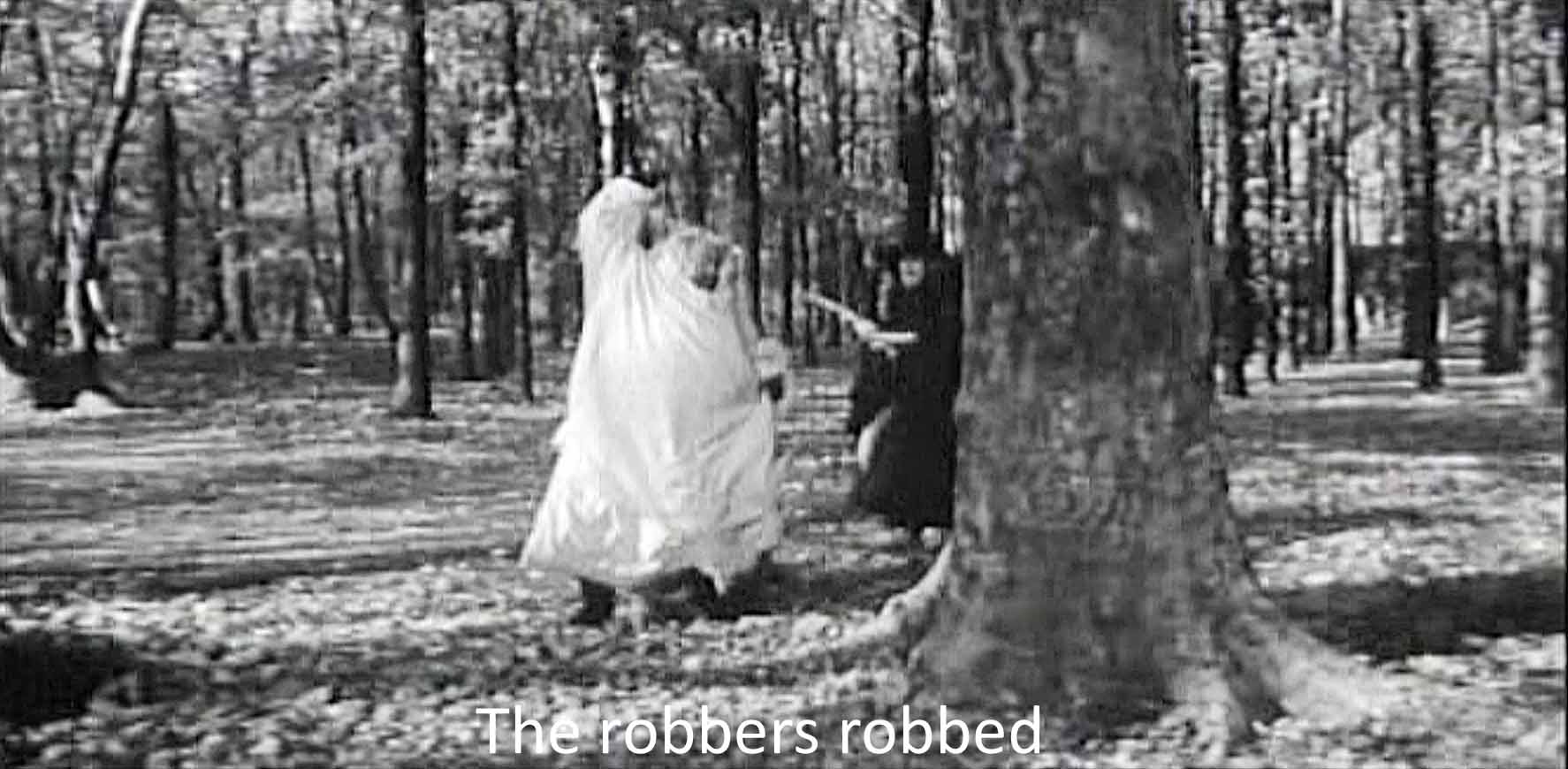Two geniuses collaborate to make one work of art. How often does that happen? And, given this great Anglo-American film, why do I have to rely on a Brazilian DVD?
The geniuses. Shakespeare is Shakespeare. Enough said. As for Orson Welles, His co-writer Herman Mankiewicz is said to have said of him, “There, but for the grace of God, goes God.” He was unquestionably a theatrical and filmic prodigy. At the age of twenty-two, he had topped the world of theater, at twenty-three, radio, and at twenty-six, he had made what many critics think is the greatest movie ever made. He was a genius, he knew it, and he acted accordingly with the result that, after Citizen Kane, he created erratically, battling studio executives, and too often failed. But genius he was nevertheless.
Two geniuses made Falstaff. Which did what? What did Shakespeare contribute? And what did Welles contribute?
Shakespeare contributed the language. Every word in this movie is Shakespeare’s except for three short excerpts from Holinshed’s Chronicles read in voiceover by Ralph Richardson. Welles pulled excerpts from the five plays in which Falstaff appears or in which he is talked about to make this film.
Shakespeare also contributed the basic plot in which the wastrel son Prince Hal (Keith Baxter) reforms. He stops being a drunken, thieving ne’er-do-well, he rejects his buddy Falstaff (Welles), and he becomes, in Holinshed’s words, “a pattern in princehood, a lodestar in honor, and famous to the world alway.” He becomes the hero-king that we see, for example, in Laurence Olivier’s Henry V.
Shakespeare contributed the basic father-son pattern within which this reform takes place. You can think of it as a kind of W with fathers above the W and sons below.  The sons are to connect with the right father, King Henry IV (John Gielgud) at the mid-point of the W. Above the W are three versions of a father. One extreme is the rebels, political fathers, who turn out to be treacherous, betraying fathers. At the other extreme is Falstaff, the dissolute father who is, we are told in so many words, the world, the flesh, and the devil, three things every good Christian should eschew. He is, so to speak, Prince Hal’s emotional father, his bosom buddy, but also his corrupter. In the middle of the W is King Henry IV who, at least at first glance, seems to be a proper father, both emotionally and politically, and the person his son should try to be.
The sons are to connect with the right father, King Henry IV (John Gielgud) at the mid-point of the W. Above the W are three versions of a father. One extreme is the rebels, political fathers, who turn out to be treacherous, betraying fathers. At the other extreme is Falstaff, the dissolute father who is, we are told in so many words, the world, the flesh, and the devil, three things every good Christian should eschew. He is, so to speak, Prince Hal’s emotional father, his bosom buddy, but also his corrupter. In the middle of the W is King Henry IV who, at least at first glance, seems to be a proper father, both emotionally and politically, and the person his son should try to be.
Beneath the W are two sons. One, Harry Hotspur (Norman Rodway), seems to be the very model of a chivalric knight, devoted to martial arts and honors. But Hotspur fails to join himself to the King and dies. The other son, Prince Hal, seems to be a total loss, a drunkard, a thief, and a wastrel, but the action of the film is to make him a true son of his father. And actually, we come to see that Hotspur is something of a jerk, at least where his beautiful wife (Marina Vlady) is concerned. It is the reformed son, the son joined to the king-father, Hal, who kills him. Hal, the Renaissance prince, triumphs in all three arenas: the tavern, the battlefield, and the court.
This core plot gives rise to a whole series of contrasts in the language that Welles carries over, between night and day, sun and moon, going on foot or on horseback, words and deeds, true words and false words, and on and on.
That would seem to be the pattern and a fairly straightforward one, but Shakespeare, being Shakespeare, complicates the picture. Henry IV is a cold man (and Gielgud’s formal way of speaking Shakespeare does him perfectly). He came to the throne wrongfully, by deposing and eventually killing Richard II, a crime that leads to the vengeful and bloody rebellion in this story. In his dying words, this king advises his son that when he becomes king, he should “busy giddy minds / With foreign quarrels; that action, hence borne out, / May waste the memory of the former days.” In other words, keep the people busy with wars overseas and they will forget how you and I came to the throne and they won’t rebel. Hardly what I would consider good kingly policy, it’s rather like what President George W. Bush did.
As for Hal, his treatment of Falstaff is downright cruel. Granted, he gives the old reprobate plenty of warning, but this is not the way you treat your closest friend. In the low plot, Hal was a thief. He robbed his fellow-robbers—a joke on Falstaff. But in the high plot he also robs: he robs Hotspur of the proud titles he had won. The people in the high plot are really not noble—Shakespeare complicates the picture.
And Welles complicates it further by the way he makes the movie. First of all, he pulls together a single plot from five Shakespearean plays, a scheme he had been fooling around with since he was a boy in prep school. Welles makes this not just the story of Prince Hal, but the story of Prince Hal and Falstaff. If anything, he puts Falstaff even more front and center than the Prince.
As always we see this new focus in the opening and closing shots. The opening is something we might see in any retirement community. Two old codgers, Falstaff and Justice Shallow, reminisce about what wild young fellows they had been when they were in college. Falstaff still behaves like an adolescent, but Justice Shallow has become old and rich and respectable—and a fool. The closing shot is the burial of Falstaff. Death as the quietus to all the chivalric and political stuff in the high plot. Welles makes Falstaff the center around whom Hal develops.
By that change in focus Welles creates a parallel that doesn’t exist in the Shakespeare plays. That is, King Henry IV rejects the rebels that have helped him to the throne. Hal, King Henry V, rejects Falstaff who, in a way, has helped him to the throne. Of his roistering with Falstaff, Hal says,
My reformation, glitt’ring o’er my fault,
Shall show more goodly and attract more eyes
Than that which hath no foil to set it off.
Paradoxically, Falstaff has helped the prince to the throne by making his reformation more “goodly.” It is Welles who creates this parallel. In Shakespeare, the rejection of the rebels and the rejection of Falstaff take place in two different plays.
Like any director, Welles creates the mise-en-scene. That is, he creates what we see before us on the screen—none of that is, or could be, Shakespeare. He creates the visual representation of these two plots, high and low. And I think he conveys the moral ambiguity by the tone. He gives us no strong blacks or whites but an abundance of gray tones. (He even burned incense for some of the outdoor scenes to tone down the Spanish sun.)
The high plot he sets in a palace that looks like a cathedral. In fact it is a cathedral, the one in Cordova. The low plot he sets in the Boar’s Head Tavern. And he sharply distinguishes these two locales.
In the court, he shoots upward. He makes his characters look big, important, and statuesque by shooting them from below. And that’s helped by John Gielgud’s plummy way of speaking Shakespeare, something the other characters make fun of. At various points, Falstaff, Hal, and Hotspur all mock Gielgud’s version of King Henry IV.
The low plot takes place in the Boar’s Head Tavern, which, despite the denials by Mistress Quickly (Margaret Rutherford), is a brothel. Here Welles shoots his characters head on or, a lot of the time, looks down on them.
The court is stone. The tavern is wood. The court has high ceilings and high stone arches and gothic windows with shafts of light streaming down The tavern has low ceilings, no windows, and horizontal beams everywhere. (Remember the famous ceilings in Citizen Kane?)
In general, the low plot has horizontal lines, the high plot verticals. By the time we get to the coronation of Prince Hal and the rejection of Falstaff, the screen is filled with vertical lances. You see practically nothing but vertical lines.
Welles adds snow. At the opening of Citizen Kane, snow marks the lost world of a childhood with a mother. Here, snow in the opening and closing scenes marks for Welles the passing of “merrie England,” a time of mythic jollity.
Welles gives us sex. Interestingly, Shakespeare exempted the prince from the wenching and whoring the other low characters indulge in. Not Welles. We see Falstaff being nuzzled by Doll Tearsheet (Jeanne Moreau) and Hal in bed with at least one lady of easy virtue. Needless to say, King Henry and the rebels have no sex associated with them, and Hotspur pushes his wife’s amorous advances away.
Welles also keeps us constantly aware of the body. We see Falstaff’s great bulk in every scene that he’s in. At one point we even see Hotspur’s bare bottom. Before the battle, we see knights weighted down with armor being hoisted onto their overburdened horses. And in the battle itself we see body after body speared or chopped or fallen and groaning.
The Battle of Shrewsbury Shakespeare would have had to do with a half-dozen actors and extras. Welles’ version is legendary. He films the battle ingeniously and brilliantly. He never could afford more than 180 extras, but he made them look like thousands. Welles filmed this ten-minute sequence in long takes, but then edited it into 200 separate shots. The effect is chaos, brutal, bloody chaos, bodies everywhere, limbs lopped off, swords and maces clanging, horses dying, mud oozing. Welles’ technique here has become the model for many later battle scenes, for example, in Braveheart or Saving Private Ryan.
In the battle, Welles makes an important change. After the Battle of Shrewsbury in which Prince Hal kills Harry Hotspur, Falstaff comes forward and claims that he killed Hotspur. In Shakespeare, this remains a joke between Hal and Falstaff. In the movie, the King is about to congratulate Hal and praise his reformation when Falstaff makes his claim. Falstaff spoils Hal’s reconciliation with his father. The Prince’s facial expression changes, and he is never again Falstaff’s buddy as he had been before. Welles motivates Hal’s final rejection of Falstaff differently from Shakespeare. Yes, Hal has to reject Falstaff if he is going to be a good king, but Welles puts in a bit of personal anger.











